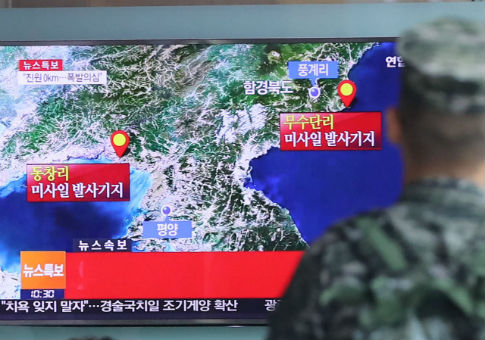By Ju-min Park and Jack Kim
SEOUL, Sept 9 (Reuters)–North Korea conducted its fifth and biggest nuclear test on Friday and said it had mastered the ability to mount a warhead on a ballistic missile, ratcheting up a threat that its rivals and the United Nations have been powerless to contain.
The blast, on the 68th anniversary of North Korea’s founding, was more powerful than the bomb dropped on Hiroshima, according to some estimates, and drew condemnation from the United States as well as China, Pyongyang’s main ally.
Diplomats said the United Nations Security Council would discuss the test at a closed-door meeting on Friday, at the request of the United States, Japan, and South Korea.
Under 32-year-old dictator Kim Jong Un, North Korea has accelerated the development of its nuclear and missile programs, despite U.N. sanctions that were tightened in March and have further isolated the impoverished country.
South Korean President Park Geun-hye, in Laos after a summit of Asian leaders, said Kim was showing "maniacal recklessness" in completely ignoring the world’s call to abandon his pursuit of nuclear weapons.
U.S. President Barack Obama, aboard Air Force One on his way home from Laos, said the test would be met with "serious consequences," and held talks with Park and with Japanese Prime Minister Shinzo Abe, the White House said.
China said it was resolutely opposed to the test and urged Pyongyang to stop taking any actions that would worsen the situation. It said it would lodge a protest with the North Korean embassy in Beijing.
There were further robust condemnations from Russia, the European Union, NATO, Germany, and Britain.
North Korea, which labels the South and the United States as its main enemies, said its "scientists and technicians carried out a nuclear explosion test for the judgment of the power of a nuclear warhead," according to its official KCNA news agency.
It said the test proved North Korea was capable of mounting a nuclear warhead on a medium-range ballistic missile, which it last tested on Monday when Obama and other world leaders were gathered in China for a G20 summit.
Pyongyang’s claims of being able to miniaturize a nuclear warhead have never been independently verified.
Its continued testing in defiance of sanctions presents a challenge to Obama in the final months of his presidency and could become a factor in the U.S. presidential election in November, and a headache to be inherited by whoever wins.
"Sanctions have already been imposed on almost everything possible, so the policy is at an impasse," said Tadashi Kimiya, a University of Tokyo professor specializing in Korean issues.
"In reality, the means by which the United States, South Korea, and Japan can put pressure on North Korea have reached their limits," he said.
UNPRECEDENTED RATE
North Korea has been testing different types of missiles at an unprecedented rate this year, and the capability to mount a nuclear warhead on a missile is especially worrisome for its neighbours South Korea and Japan.
"The standardization of the nuclear warhead will enable the DPRK to produce at will and as many as it wants a variety of smaller, lighter, and diversified nuclear warheads of higher strike power," KCNA said, referring to the country’s formal name, the Democratic People’s Republic of Korea.
It was not clear whether Pyongyang had notified Beijing or Moscow of its planned nuclear test. Senior officials from Pyongyang were in both capitals this week.
Chinese Foreign Ministry spokeswoman Hua Chunying said she had no information to provide when asked if China had advance warning of the test, and would not be drawn on whether China would support tougher sanctions against its neighbor.
Although Beijing has criticized North Korea’s nuclear and missile tests, it has repeatedly expressed anger since the United States and South Korea decided in July to deploy the Terminal High Altitude Area Defense (THAAD) anti-missile system in the South.
China calls THAAD a threat to its own security and will do nothing to bring North Korea back to the negotiating table on its nuclear program.
Preliminary data collected by the Vienna-based Comprehensive Nuclear-Test-Ban Treaty Organization (CTBTO), which monitors nuclear tests around the world, indicates the magnitude–around 5–of the seismic event detected in North Korea on Friday was greater than a previous one in January.
Jeffrey Lewis of the California-based Middlebury Institute of International Studies said the highest estimates of seismic magnitude suggested this was North Korea’s most powerful nuclear test so far.
He said the seismic magnitude and surface level indicated a blast with a 20- to 30-kilotonne yield. Such a yield would make this test larger than the nuclear bomb dropped by the United States on the Japanese city of Hiroshima in World War Two.
"That’s the largest DPRK test to date, 20-30kt, at least. Not a happy day," Lewis told Reuters.
South Korea’s military put the force of the blast at 10 kilotonnes, which would still be the North’s most powerful nuclear blast to date.
"The important thing is, that five tests in, they now have a lot of nuclear test experience. They aren’t a backwards state any more," Lewis said.
